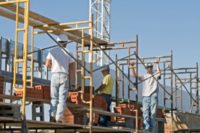Each year, members of the cancer community recognize Mesothelioma Awareness Day (MAD) by spreading awareness about the disease. Mesothelioma is a preventable type of cancer caused by exposure to asbestos. Today, laws prohibit new uses of asbestos in the U.S, but construction workers continue to be at risk of exposure from old uses of the mineral.
The Occupational Safety and Health Administration (OSHA) has created laws to protect workers from dangerous airborne particles. However, respiratory protection was the third most cited OSHA violation in 2020. To prevent asbestos exposure in the workplace, it’s important for construction workers and employers to understand proper safety practices.
Why are construction workers at risk of asbestos exposure?
Until the 1980s, asbestos was widely used to construct many homes and buildings. The mineral was popular in construction because of its strength, durability and resistance to heat. For decades, construction crews utilized asbestos products in insulation, roofing, drywall, plumbing and a variety of other areas.
As the dangers of asbestos became known, OSHA created regulations to protect workers from exposure. The Environmental Protection Agency (EPA) also limited the asbestos use in new products. Unfortunately, homes and buildings constructed before the 1980s may still contain asbestos products.
Today, construction workers risk asbestos exposure during renovations and demolitions of older structures. If an asbestos-containing material breaks apart at a construction site, fibers may be released into the air. Workers who inhale airborne asbestos fibers risk developing mesothelioma or lung cancer later in life.
Protections and safety measures for workers
To protect workers from asbestos exposure, OSHA outlines specific standards for the construction industry. Building owners and employers of construction workers are required to follow specific rules under these standards.
Employers must closely monitor the air quality at job sites where asbestos may be present. Individuals working in areas with asbestos-containing materials should be provided with the appropriate personal protective equipment, such as ventilators. Employers must also provide medical monitoring and exams to individuals working in an asbestos-contaminated area.
The EPA’s Clean Air Act also requires employers to follow certain protocols. For example, work areas must be thoroughly inspected before a renovation or demolition. If the presence of asbestos-containing materials is suspected, the renovation owner or operator is required to notify the appropriate state agency. Most states then require contractors to submit a plan to remove the hazardous materials.
Safely removing asbestos materials
The best way to safely remove asbestos-containing materials from a construction site is to hire a professional abatement contractor. Asbestos abatement professionals are educated on how to remove the material according to state and federal standards.
Professional abatement contractors must also be licensed to legally remove asbestos-containing materials. Employers should never permit unlicensed construction workers to remove asbestos materials. Improper removal of asbestos can put workers and individuals nearby at risk.
Employers who do not comply with state and federal asbestos regulations can face hefty fines and potential jail time. These regulations exist to protect workers and the public from mesothelioma and other asbestos diseases.



